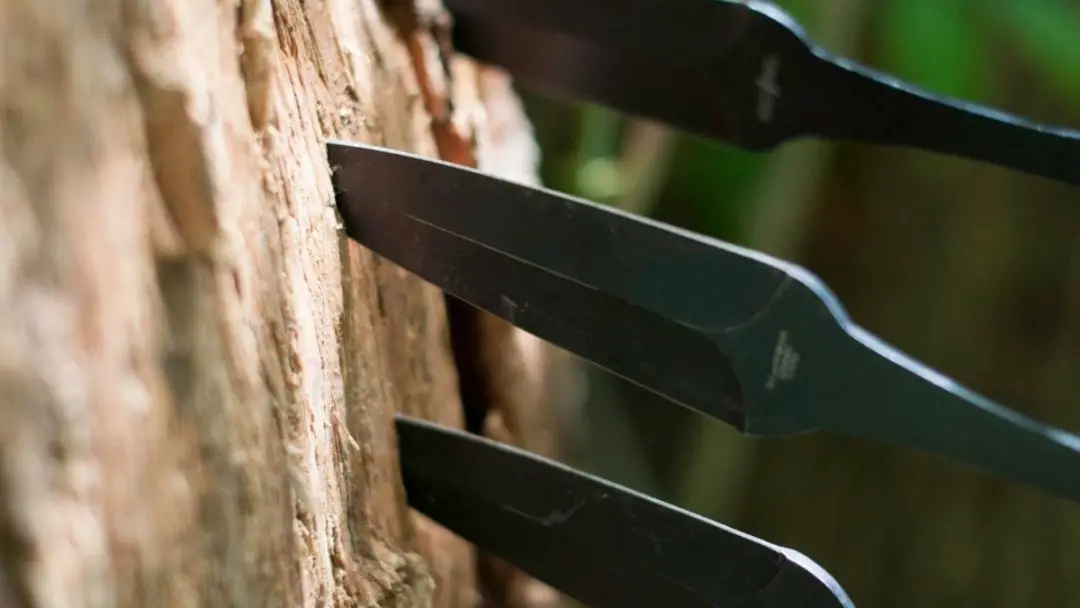
Knife throwing is a fascinating and largely overlooked activity. When you think about activities to do with a knife, knife throwing usually pops up in your mind as a possible activity. But how large and popular is the activity and is it considered a sport? I did a fair amount of research and this is what I came up with to answer these questions and more.
Knife throwing is a hobby, entertainment act, and competitive sport that many people all over the world enjoy playing. While it is usually not considered a mainstream sport and isn’t streamed on television often, there are many knife throwing clubs that hold competitive competitions.
Especially once you begin to look into it, knife throwing becomes a very fascinating subject and activity that has a lot more to it than you might expect. Knife throwing rules, clubs, and competitions are very diverse and the activity has many devoted fans. Below I will go more in-depth into whether or not knife throwing is considered a sport as well as many other things regarding competitions and the activity as a whole.
Table of Contents
Is Knife Throwing Recognized as a Sport?
From what I have discovered and read from researching the topic, knife throwing is not really considered a mainstream sport anywhere in the world. It does have a loyal base of fans and participants that treat it like a sport and hold competitive companions and the like, but it is almost never streamed on televisions and there is no universal governing organization.
Knife throwing is becoming more and more popular though, so this could change in the near future and it could become more of a mainstream and recognized sport.
Almost everywhere in the world, there is at least one knife throwing club or group that practice knife throwing and hold local competitions of the activity. These competitions are usually just held locally and are pretty small. However, in places where there are multiple knife throwing clubs, they might come together to compete.
There are organizations, such as the American Knife Throwers Alliance (AKTA), UK Knife, Axe & Tomahawk Throwing Association (KATTA), and Eurothrowers that try to set standards for knife throwing by hosting events and writing out rules and regulations. There are competitions that follow the rules and standards set by these organizations, and there are those that have their own governing association or club that they follow the rules of.
Basically, there is no universal governing organization for knife throwing, and therefore it often seems like a very rough and rudimentary sport. Knife throwing does have a loyal base of fans and participants that consider it a sport, but it just isn’t very mainstream or popular.
What are the Rules at Knife Throwing Events?
The rules at knife throwing events vary from competition to competition. It really all depends on where the event takes place and what organization or group they recognize the rules from.
Because there is no universal governing organization for the sport of knife throwing, there are many different sources for competition rules. While all of the rules seem to follow a similar structure and pattern, there are discrepancies and differences and this makes it very hard to set “standard” knife throwing rules.
Knife throwing competitions are usually set up to have a number of different events. Some competitions only have one or two events, while others offer all of them or even make some of their own up for fun. Some of the standard knife throwing events according to Eurothrowers are:
- Walk-back precision throwing
- Single distance precision
- Long-distance
- Sports silhouette throwing
- Duel-Cup
- No-spin knife throwing
The above events (except for single distance precision) are required to be held at any competition that follows European Knife Throwing and Axe Throwing Rules. Other competitions that do not follow these rules might include some or all of the above events or they could have completely different ones. Below I will quickly go over the different events and how they are each typically conducted.
Walk-Back Precision Throwing
This event is set up with a target and five markers at varying distances from that target. The five different markers are set at 3m, 4m, 5m, 6m, 7m (9.8ft, 13.1ft, 16.4ft, 19.7ft, 23ft). The event is split into four rounds, in each round, the thrower cycles through all of the five distance markers and throws three knives at each marker.
Each round should result in a total of 15 throws (5 distances x 3 throws at each distance). At the end of the event, after four rounds, each thrower should have thrown a total of 60 times (5 distances x 3 throws at each distance x 4 rounds). The competition is judged and scored upon accuracy. (Source)

Single Distance Precision
Single distance precision knife throwing events are just as the name implies, the thrower throws knives from a single distance from the target for a final score. This event is held at 3m, 5m, 7m (9.ft, 16.4ft, 23ft).
For each event, throwers are allowed 21 or 15 throws depending on the competition and conditions. At each distance, throwers are allowed to declare one practice throw before their other 21 or 15 throws to help gauge distance. The practice throw must be declared BEFORE they throw. This event is judged and scored upon accuracy. (Source)
Long-Distance
This event is conducted with a single circular target that has a 1m (3.3ft) diameter. The minimum throwing distance is 4m (13.1ft). After the minimum distance, the throwing range is split into sections that are 3m (9.8ft) in length and start at the minimum distance. The range is divided into sections that are as follows, 4-7m, 7-10m, 10-13m, etc. (13.1-23ft, 23-32.8ft, 32.8-42.7ft, etc.)
The thrower chooses a distance within the first section of the range (4-7m) and throws three knives with no test or practice throws permitted. If the thrower is able to make one of their knives stick into the target, they move on to the next section of the range and repeat their three throws. The event ends when a thrower is unable to get one of their knives to stick and their longest distance is recorded. (Source)
Sports Silhouette Throwing
Sorts silhouette throwing events are a little more challenging than the previous ones we have talked about because it requires precise aim and control. The single target in this event has 2 larger red dots on it and these large dots are surrounded by 15 numbered smaller black dots.
Standing 3m (9.8ft) away from the target, the thrower must throw their knives at the smaller black dots and hit them in numerical order. If a knife touches the larger red dots, the thrower loses points. This is a very difficult event because you have to have a really good aim so that you don’t hit the red dots and so that you can hit the smaller black dots in the correct order. (Source)
Duel-Cup
The duel-cup event is probably one of the most advanced and more difficult events to be found at a knife throwing competition. Throwers compete in pairs (duels) from a distance of 3-3.5m (9.8-11.5ft). There is one target per thrower that has a diameter of 50cm (1.6ft). Each duel consists of 3 runs.
At the beginning of each run, all throwing knives are secured in their sheaths and either on the throwers belt or tucked into their clothing. When the referee starts a measuring device, the two throwers competing in the duel have five seconds to throw their knives as accurately and as fast as they can. The first person to have their knife stick into the target wins the run. Whoever wins the most runs in a duel, wins the duel. The person that wins the duel moves on to the next round until there is only one winner left at the competition. (Source)
No-Spin Knife Throwing
Often done using the same style and rules as a walk-back precision throwing event, the no-spin knife throwing event requires a lot of skill and practice. Usually, a thrower throws their knives with two or three rotations, and it is really difficult to throw a knife accurately without any rotations.
This is essentially the same type of event as a walk back precision throwing event, the only difference is that the throwing knives must not rotate in the air on their way to the target. For specifics about how this event is run, see “Walk-Back Precision Throwing” earlier in this article. (Source)
Who is in Charge of Knife Throwing Events?
Knife throwing events are usually not very large and there just aren’t that many people to score and keep track of. Usually, there are at least a few people designated to keep score and make sure that everyone is following all of the rules. There really aren’t that many rules in knife throwing so a lot of knife throwing competitions are highly self-regulated.
There is usually the main person who is the host of the competition who is the arbiter of the event and settles any disputes. There are sometimes judges assigned to keep score and make sure that everyone is playing nice, but knife throwing competitions rely heavily on honesty and participants looking over each other’s scores.
Some knife throwing competitions are more organized and official than others, so in some cases, there are assigned referees, judges, arbiters, who are very strict and make sure that everything is recorded accurately and that there is no cheating.
Conclusion
Overall, knife throwing is a very intriguing and fascinating sport that, while it isn’t widely practiced and recognized, has a loyal fan base and a group of participants. There really isn’t a universally excepted governing organization for the sport, so the rules tend to change wherever you go and depending on what competition you are competing in.

